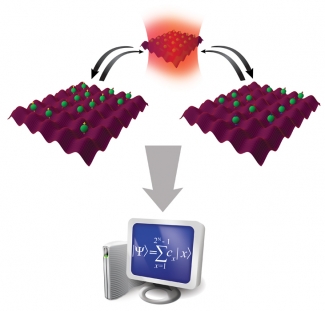In the summer of 2008, Fellow Jun Ye spent a couple of months at CalTech, where he ran into another visiting professor, former JILA Fellow Peter Zoller. Zoller left JILA in 1994 to become Professor of Physics at the University of Innsbruck (Austria). Besides riding bikes together in the mountains, the two men engaged in happy and fruitful discussions about Ye’s work developing a strontium- (Sr-) based optical atomic clock and Zoller’s pioneering research on quantum computing. It took them a matter of a couple of weeks to come up with a basic theoretical framework for a quantum computer based on alkaline-earth metals such as Sr.
With the critical input of colleagues Andrew Daley of Innsbruck and Marty Boyd, a research associate at JILA, Zoller and Ye proposed solutions for the key problems of storing, addressing, and transporting qubits in a quantum information processing system based on neutral atoms confined in an optical lattice. The researchers figured out how a Sr-based quantum computer could store qubits, which represent coherent superpositions of atomic states. They came up with a plan for talking to individual atoms. And, they worked out a scheme for selecting a single atom, moving it to another location on the lattice to interact with another qubit, and then moving it back, all under coherent control.
Their solutions involved two specially engineered optical lattices made with light at wavelengths that address specific properties on how atoms interact with the trapping light.1 The optical lattices for a Sr quantum computer would be created with two separate wavelengths of red light. One wavelength (689.2 nm) would have no net effect on atoms in their electronic ground state, while the other (627 nm) would have no net effect on atoms in their electronically excited, but metastable, state. Both states are long-lived, which is a requirement for quantum computing. The 689.2 nm lattice would be the qubit "transport" lattice, and the 627 nm lattice would serve as the qubit “storage” lattice.
The storage lattice would hold qubits (i.e., information encoded on the nuclear spins of Sr atoms) in the ground state. When a specific atom needs to be transported, it could be excited to the electronic metastable state and loaded into the transport lattice where its motion could be precisely controlled.
The electronic structure of Sr atoms allows them to store and hide stable, coherent information. Because Sr atoms have two valence electrons, both their ground- and metastable states are minimally affected by external magnetic fields. This insensitivity to magnetic fields means that their robust nuclear spins can form long-term qubits. Equally importantly, a third electronically excited state with a high sensitivity to magnetic field can be used to select a specific atom from the lattice for operations. This selection is accomplished by applying a magnetic-field gradient across the lattice and creating location-dependent frequency shifts in that third electronic state.
This is where the precision Sr atomic clock laser2 comes in. The clock laser makes it possible to precisely detect, measure, or manipulate atoms in the storage and transport lattices. The beauty of this laser is that it can accurately address one or more individual frequencies encoded on the qubits and, with the help of the third electronic state, transfer only those particular qubits into the transport lattice.
The movement of the storage and transport lattices relative to each other allows the computer to perform calculations with information "retrieved" by the clock laser from different parts of the storage lattice. The calculations are performed via the so-called quantum gate operations, where two atoms coming into contact in a single lattice site interact via that third electronically excited state. Once a calculation is complete, the clock laser dumps the metastable qubits back into the storage lattice. In theory, the Sr quantum computer works like a charm.
It has great promise in the laboratory, too. Ye believes that his group's Sr lattice atomic clock development has already laid the foundation for building a prototype Sr quantum computer. "I believe that whether we are building an atomic clock or a quantum computer, we are performing different aspects of the same work," says Ye. "What we are doing is creating and preserving quantum coherence. For quantum computers, having atoms interact with each other in a controlled manner will be the key." - Julie Phillips



 The Physics Frontiers Centers (PFC) program supports university-based centers and institutes where the collective efforts of a larger group of individuals can enable transformational advances in the most promising research areas. The program is designed to foster major breakthroughs at the intellectual frontiers of physics by providing needed resources such as combinations of talents, skills, disciplines, and/or specialized infrastructure, not usually available to individual investigators or small groups, in an environment in which the collective efforts of the larger group can be shown to be seminal to promoting significant progress in the science and the education of students. PFCs also include creative, substantive activities aimed at enhancing education, broadening participation of traditionally underrepresented groups, and outreach to the scientific community and general public.
The Physics Frontiers Centers (PFC) program supports university-based centers and institutes where the collective efforts of a larger group of individuals can enable transformational advances in the most promising research areas. The program is designed to foster major breakthroughs at the intellectual frontiers of physics by providing needed resources such as combinations of talents, skills, disciplines, and/or specialized infrastructure, not usually available to individual investigators or small groups, in an environment in which the collective efforts of the larger group can be shown to be seminal to promoting significant progress in the science and the education of students. PFCs also include creative, substantive activities aimed at enhancing education, broadening participation of traditionally underrepresented groups, and outreach to the scientific community and general public.